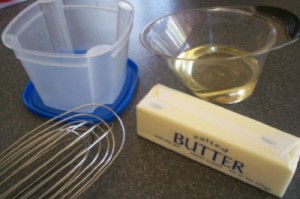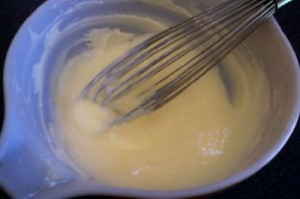I’m not sure what to call this stuff. My post the other day about eating real food caused me to reflect on what we spread on bread. Traditionally, we don’t use butter in my house. I don’t buy margarine either, but I do buy butter spreads- our favorite being Brummel & Brown. So we use this spreadable stuff on bread, pancakes, waffles, toast, and things of that nature. The appeal of the spreads is that they are spreadable right out of the fridge- cold butter is not. But have you ever read the label of a butter spread? Yeah… more of those chemicals and stabilizers and things we cannot pronounce and wonder if we should be eating.
So last summer, while at my aunt and uncle’s house celebrating Independence Day, I learned very easily how to make my own spread, but then completely forgot about it until the other day. Then, of course, that led to me asking Andy if he remembered the proportions, and a message had to be sent to find that all out.
Easy as pie. You only need two ingredients. A stick of real butter and 3 fluid ounces of the oil of your choice. Choose a heart healthy oil, such as canola, olive, peanut, sunflower or safflower oil. Personally, I prefer a neutral tasting oil as well- canola and peanut work well there. Olive oil is good, but a nicely flavored olive oil just doesn’t taste as well to me spread on toast and sprinkled with cinnamon sugar. But use olive oil if you prefer. I’m using peanut today.
Let the butter soften to room temperature. Once it’s very soft, put it in a mixing bowl along with the oil. Use a whisk or a hand mixer to blend the two together. Your mixture will look like unset pudding. This is exactly the consistency you are looking for.
Then you simply pour it into a resealable container and pop it in the fridge. The spread will set up a bit once chilled, but it’s completely spreadable cold and out of the fridge. Perfect for using anytime a smear of butter is called for.
If you want to make it in a larger quantity, use two sticks of butter (1 cup) to 3/4 cup of oil. And of course, you can also use this as a platform for a multitude of other uses. Use these proportions and add garlic and herbs for an instant spread for garlic bread. Really, creatively speaking, you could probably mix in just about anything to customize your own delicious spreads straight out of the fridge. Just keep in mind that fresh foods, like fruit bits, fresh garlic and herbs will shorten the shelf life to about a week. But I imagine they could be frozen for long term storage.
Homemade spreadable butter. It’s an excellent thing and a great budget stretcher.



Thanks for the useful suggestions. Discover more at wood flooring
This was very beneficial. For more, visit san diego roofers
Its like you read my mind! You appear to know so much about this, like
you wrote the book in it or something. I think that you can do with a few pics to drive the message home a little bit, but other than that, this is great blog.
An excellent read. I’ll definitely be back.
Also visit my web site – A?
Your aspiration home must certainly not only appear gorgeous however additionally perform effectively for your family members’s needs– a guideline our company observe carefully at Keechi Creek Builders! custom home builder houston
Thanks for the useful post. More like this at heating
Professionalism meets creativity at its finest with Keechi Creek Builders—their innovative designs speak volumes about their expertise!!! bathroom remodel houston
I found incredible design ideas custom home builders houston texas
Wow, I didn’t realize how many conditions a Tacoma chiropractor can treat! This opens up new possibilities for my health journey Car accident chiropractor Tacoma
Understanding insurance policies is so important after an injury Personal injury lawyer Salt Lake City
Your insights on kitchen trends are spot on! Have you considered incorporating smart technology into your remodel? It adds both convenience and value kitchen remodeling houston tx
Ventilation is often overlooked but so important in kitchen design! It’s reassuring that companies like Keechi Creek Builders prioritize this aspect during renovations for health and comfort reasons kitchen contractor
Can someone share their experience with different types of covers before doing a pool opening? pool opening services
This was a fantastic resource. Check out floral designers long island for more
Finding reliable and knowledgeable legal counsel can be daunting; however injury lawyers
“Embracing creativity leads toward innovation propelling us forward generating excitement enabling limitless possibilities ultimately leading accomplishments cherished wholeheartedly bathroom remodel houston
I found this very helpful. For additional info, visit gas cooker installation
Douglasdale’s best-kept secret is the dentist at endodontist in my area – they really know how to take care of their patients
I’d love to hear about unique plumbing solutions people have used during their renovations—share your stories! #HoustonPlumbing bath remodel
Just got my pergola installed, and I love it! If you’re searching for local services, check out Outdoor Landscaping Services
Don’t let the stress of a personal injury claim overwhelm you—find a supportive attorney right here in Ronkonkoma! Divorce Lawyer Ronkonkoma
Apple.com/bill appears on your statement of billing whenever you buy items from the Apple.com Store or iTunes.com Store.
You can, for instance, purchase an app film, music, or any other type
of media. This brief and simple statement of billing can help identify the
source of the purchase.
Planowanie instalacji elektrycznych w budynkach mieszkalnych to procedur? niezb?dnym do przeprowadzenia precyzyjnego rozwa?enia specyfikacji systemu i stosowania standardów bezpiecze?stwa.
Podstawowym zadaniem przygotowania projektu by? gwarancja bezpiecze?stwa osób korzystaj?cych
oraz optymalnego dzia?ania sieci elektrycznej.
Przede wszystkim trzeba przeprowadzi? rzeteln? ocen?
wymaga? technicznych oraz ustali? parametry eksploatacyjne a
tak?e odpowiednie metody zabezpiecze? przed pora?eniem pr?dem.
Nast?pnie jest sporz?dzeniu szczegó?owej dokumentacji technicznej,
w której zawarte s? diagramy instalacji oraz opis u?ytych
materia?ów.
Kluczowym aspektem tworzenia stanowi wybór odpowiednich komponentów, które musz? spe?nia? aktualne standardy.
Wa?ne jest, ?eby ka?da cz??? wp?ywa na funkcjonalno?? uk?adu.
Dodatkowo istotne jest tak?e zapewnienie mo?liwo?ci ?atwej konserwacji oraz mo?liwo?ci rozbudowy w przysz?o?ci.
Reasumuj?c, zasady projektowania instalacji elektrycznych bazuj?
na starannym planowaniu i przestrzeganiu norm bezpiecze?stwa.
Skrupulatne planowanie zapewnia niezawodne dzia?anie instalacji
i ogranicza niebezpiecze?stwa u?ytkowania.
Z tego wzgl?du ka?dy plan powinien odzwierciedla? obowi?zuj?cymi przepisami,
które stanowi gwarancj? bezpiecze?stwa oraz bezproblemowej eksploatacji instalacji.
Just had my ducts cleaned by StarDucts last week—what a difference it made! Dryer Vent Cleaning
Hoeever that success additionally has attracted a wealth of competitors, as
Fitbit acknowledges in its IPO filing.
My blog – bandar togel online
Friends of mine used water damage restoration near me for their water damage issues
Moving can be overwhelming, but with moving companies brooklyn , it felt organized and simple
If you’re looking for reliable movers in Brooklyn, check out moving companies
Huge thanks to **`movers`** from ### `movers `###for their exceptional service during our recent move—we couldn’t have done it without Buy The Hour Movers Brooklyn
This was quite informative. More at https://primeranota.com.do/jose-horacio-aspira-a-la-vicepresidencia-de-opcion-democratica/#comment-23409
My go-to resource for local moving services is always moving companies brooklyn —they never
This was highly educational. For more, visit plumbing
I am looking forward to implementing your suggestions for improving my home’s heating and cooling efficiency this season! More tips available at AC installation company
Thanks for the helpful article. More like this at Oro Valley Realtor
Appreciate the detailed information. For more, visit wedding florists long island
Fire damage can be more than just physical destruction; it can also leave emotional scars. Having the right support and knowledge is essential for recovery. For comprehensive resources, make sure to visit Fire Damage Restoration
I can’t recommend using a local mover enough! My experience was fantastic—more details on this at Karma Movers St Petersburg FL
For anyone considering a move local moving st petersburg
Do you have any specific recommendations for #moversbronx? I’m exploring options like Bronx Moving Company – Flat Fee Moving LLC
Does anyone have experiences with movers in the Bronx? Would love to
Useful advice! For more, visit long distance movers near me
Moving plants over long distances can be tricky; any advice? I’ve gathered some tips at long distance mover
Planning ahead ensures unnecessary headaches avoided down line especially given challenges faced involving distances traveled cross country movers
Thanks for the helpful advice. Discover more at Plumber Near Me
Lots of people take too lightly the value of having strong defense methods led by qualified lawyers– do not make that blunder if faced with charges! best criminal lawyer
If you’re looking for a compassionate and experienced professional to help you navigate life’s challenges, I highly recommend seeking out a psychologist in Los Angeles Psychologist Los Angeles
The staff at Pressure Washing are true professionals when it comes to pressure washing
Best boston search engine marketing employer GreenBananaSEO money them out SEO agency
Helpful suggestions! For more, visit packers near me
I found this very interesting. For more, visit plumbing
Thanks for the helpful article. More like this at Best Insulation Contractors